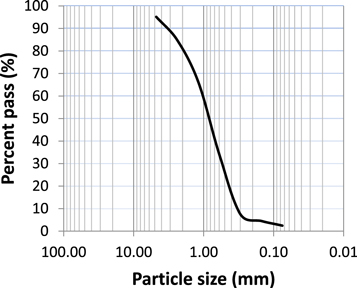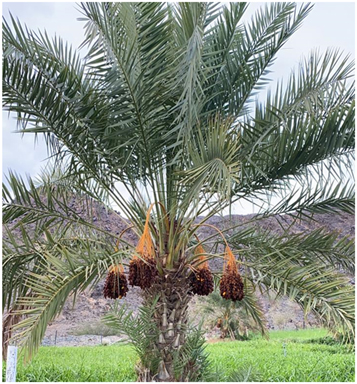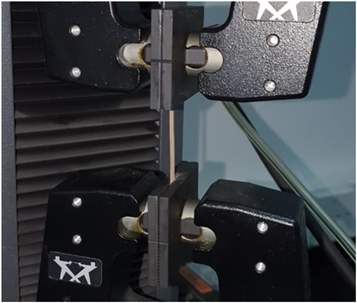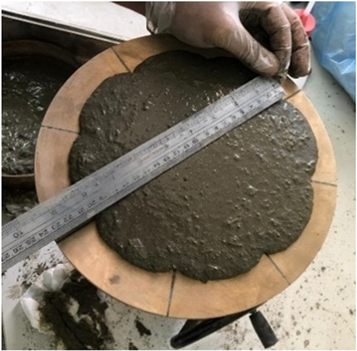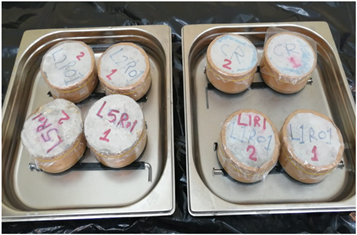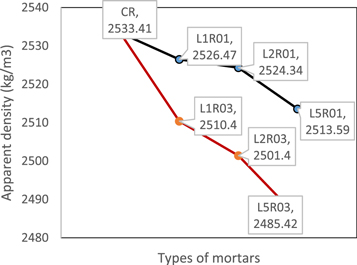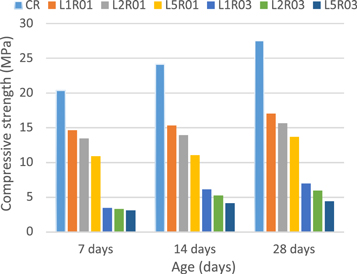Abstract
This paper presents the results of a study conducted to investigate the effects of incorporating Sefri Date Palm Leave Fibers (SDPLF) into the mortar. A total of seven mixtures were prepared and tested. SDPLF were collected from local farms. The fibers were then cleaned, dried, and cut to different sizes of 10 mm, 20 mm, and 50 mm, maintaining the same individual fiber width of approximately 5 ± 2 mm. The content of SDPLF in mortars was kept to 1% and 3% by mass. The physical and mechanical properties of SDPLF fibers and SDPLF mortars were investigated. The compressive strength at 7, 14, and 28 days was determined. The water absorption rate test was carried out on mortars containing 1% SDPLF fibers. The results showed that mortars with SDPLF have lower workability, lower density, and lower compressive strength as compared to control mortars. However, they are still acceptable for use in construction works. Mortars containing 10 mm and 20 mm SDPLF fibers by mass showed significant improvement in terms of water absorption rate as compared to the control mortar.
Export citation and abstract BibTeX RIS

Original content from this work may be used under the terms of the Creative Commons Attribution 4.0 licence. Any further distribution of this work must maintain attribution to the author(s) and the title of the work, journal citation and DOI.
1. Introduction
Agricultural wastes could be considered a renewable source. With the very huge consumption of energy and carbon dioxide in the building sector, agricultural wastes rank high as a promising friendly and economic material. Low-cost, good thermal and mechanical properties, renewability, widespread, and environmentally friendly are some advantages of agricultural wastes. According to 2030 vision, the government of Saudi Arabia emphasizes recycling and utilizing agricultural wastes in such ways that lead to a safe and clean environment. Date palm is widely cultivated in the Middle East and North Africa, and less so in other parts of the world. For example, date palm is the major fruit crop in Saudi Arabia, covering approximately 72% of the total area under permanent crops with an estimated 23 million date palm trees [1], while Algeria has more than 10 million date palms [2]. A huge quantity of waste material is produced from seasonal pruning and trimming of the palm trees, which can be estimated by an average of 35 kg per tree [3]. Thus, million metric tons of palm date waste materials are produced and simply dumped in landfills causing environmental and fire hazards.
Many researchers have been investigating the feasibility of using date palm fibers (DPF) in cement-based materials [4–16]. They concluded that some properties of concrete and mortar could be improved. For example, the mechanical properties of cement-based materials incorporating DPF were investigated. It was found that the compressive and flexural strength and fracture toughness decreased as a function of DPF content [2, 4–6]. The reduction in the compressive strength of DPF mortars was up to 80%, with DPF content of 48%, w/v [7]. On the other hand, the flexural behavior of DPF cement-based materials was improved as some ductile behavior was noticed [7–9]. The water absorption of DPF mortars was also investigated. It was found that the water absorption increased with DPF content [4, 10, 11]. Swelling, drying shrinkage, and chemical resistance to acidic solutions were investigated for mortar containing DPF [12], showing better performance than control mortar against shrinkage and acidic attacks. To improve the mechanical properties of reinforced DPF mortar, the DPFs are pre-treated by different methods such as boiling in water, immersing in sodium and calcium hydroxide, and coating with oil [13–15]. Mortars containing treated DPF showed better mechanical properties than mortars containing untreated DPF fibers. The thermal conductivity, thermal effusivity, and thermal diffusivity of cement-based materials containing DPF were also studied [4, 8, 9, 16]. All studies concluded that the thermal properties improved as DPF content increased.
Considering the Palm date industry as a renewable resource, it could be a friendly environment alternate solution to using Palm date waste in cement-based materials to improve their mechanical, thermal, and durability properties and eliminate such wastes safely. The huge amount of seasonal pruning and trimming of the palm trees' waste comes from leaves, not trunks, which makes it essential to conduct more research on utilizing the leaves of palm trees in cement-based materials. In this paper, the mechanical and physical properties of mortar incorporating Sefri Date Palm Leaves Fibers (SDPLF) are investigated. The mechanical and physical properties of SDPLF are also presented and discussed.
2. Experimental program
2.1. Materials
Ordinary Portland cement type I was used. Natural sand was collected from the Wadi Bisha rainfall stream with a specific gravity of 2.67. Figure 1 shows the particle size distribution of the used sand. Sefri Date Palm (a type of date palm in Saudi Arabia (figure 2)) Leave Fibers (SDPLF) were collected from a local farm at Bisha. The SDPLF leaves were cleaned, dried, and then cut to specified lengths of 10 mm, 20 mm, and 50 mm. The width of each tuft was kept as 5 ± 2 mm on average. SDPLF fibers were incorporated into the mixtures by 1% and 3% by mass.
Figure 1. Particle size distribution of the used sand.
Download figure:
Standard image High-resolution imageFigure 2. Sefri date palm tree.
Download figure:
Standard image High-resolution image2.2. Mix proportion
A total of seven mixtures of mortar were prepared, including the control mixture. Table 1 shows the mix proportions and SDPLF ratio and sizes for all mixtures. The sand was first mixed with SDPLFs and cement to ensure the equal distribution of SDPLFs among the mixture, as shown in figure 3; the mixing water was then gradually added, and the mixer was run for about 3 min. The mortar was then placed in the molds and properly compacted. The specimens were left in the molds for 48 h, then demolded and placed in a water tank until the day of the test. L1R01 is a mixture where the length and percentage of SDPLF are 10 mm and 1%, respectively.
Table 1. Mix proportion of mortars.
| Mixture | SDPLF (%) | SDPLF Length (mm) | w/c | Cement/sand |
|---|---|---|---|---|
| CR (Control) | 0 | — | 0.5 | 1/2 |
| L1R01 | 1 | 10 | 0.5 | 1/2 |
| L2R01 | 1 | 20 | 0.5 | 1/2 |
| L5R01 | 1 | 50 | 0.5 | 1/2 |
| L1R03 | 3 | 10 | 0.5 | 1/2 |
| L2R03 | 3 | 20 | 0.5 | 1/2 |
| L5R03 | 3 | 50 | 0.5 | 1/2 |
Figure 3. Addition of SDPLF to sand before mixing with water.
Download figure:
Standard image High-resolution image2.3. Tests
2.3.1. SDPLF properties
The physical properties of SDPLF (i.e. bulk density, absorption, and apparent specific gravity) were determined in accordance with ASTM C 127 [17]. A sample of SDPLF was weighted as received (Wr), then the sample was dried in Oven at 110 °C until a constant weight was obtained; this weight was recorded as oven-dried weight (Wo). The sample was then immersed in water for 24 h and weighted in water. This weight was recorded as immersed weight (Wi). As the last step, the water on the SDPLF was properly wiped using a piece of cotton cloth. The weight of the sample was then recoded as saturated surface dry (WSSD).
The bulk density, apparent specific gravity, and absorption were determined, respectively, as follows:



The tensile strength of SDPLF was also determined. Three SDPLF samples of 50 mm length (with a tuft of 5 mm) were tted in air-dry conditions. Mini INSTRON universal Testing Machine was used. Figure 4 shows the SDPLF sample installed on the machine.
Figure 4. SDPLF sample in the tensile test machine.
Download figure:
Standard image High-resolution image2.3.2. Mortar properties
To investigate the effects of SDPLF on mortar's properties, workability, density, absorption, compressive strength, and absorption rate were investigated. A flow table test was conducted in accordance with ASTM C230 for each mixture to investigate the workability of mortar containing SDPLF. After 25 drops of the flow table, the diameter of the mortar was measured in four directions. The average of the measured diameters was used to interpret the results. Figure 5 shows the flow table test while measuring diameters.
Figure 5. Flow table test.
Download figure:
Standard image High-resolution imageAfter 28 days of curing in water, the apparent density and absorption of mortars were tested in accordance with ASTM C40. The apparent density and absorption of mortars were determined as an average of five cubes of 100 mm length. The cubes were oven-dried at 110 °C for about 26 h, then left to cool to measure the mass. Later, the cubes were immersed in water for 48 h, and the mass was recorded at saturated service dry (SSD). Also, the submerged masses (in water) of SSD cubes were determined. The apparent density and absorption of mortars were calculated using equations (4) and (5), respectively:


Also, six cubes of 100 mm were cast to determine the compressive strength of mortar at 7, 14, and 28 days, in accordance with ASTM C109. A compression test machine o3000 kN capacity was used to test the cubes with a stress increment of 0.15 MPa s−1. To investigate the effects of SDPLFs on the water absorption rate of the mixtures, a test was carried out in accordance with ASTM C1585 [18]. Two cylindrical samples of 100 mm diameter and 50 mm height for mixtures L1R01, L2R01, and L5R01 were cast and cured in water for up to 28 days. The samples were then conditioned by placing them in a desiccator inside an oven at a temperature of 50 °C for 3 days. The relative humidity in the desiccator was controlled at about 80% with a saturated solution of potassium bromide. The samples were kept in sealable containers to the day of the test. The test was conducted according to the procedure described in the standard. The side surface and the top face of the specimens were sealed. The sealed specimen weight was recorded as the initial weight. The specimens were then placed in water where the bottom face is exposed to water. The weight of the specimens was recorded at different time intervals ranging from 1 min to 7 days, as prescribed in the standard. The initial and secondary rates of water absorption were defined as the slope of the line that is the best fit to the absorption plotted against the square root of time using all the points from 1 min to 6 h. and from 1 day to 7 days, respectively. Figure 6 shows the specimens during the test.
Figure 6. The specimens during the water absorption rate test.
Download figure:
Standard image High-resolution image3. Results and discussion
3.1. Physical and mechanical properties of SDPLFs
Bulk density, absorption, and the specific gravity of SDPLF fibers were determined as the average of two samples. The results are summarized in table 2. With a bulk density of 1277. 27 kg m−3, the SDPLF could be classified as lighter fibers as compared with cotton, jute, flax, hemp, abaca, ramie, and sisal [19, 20]. Even though the absorption capacity of SDPLF is as high as 94.4%, SDPLF fibers could be classified as lower porous structure fibers (i.e., lower absorption capacity) compared with sisal, wheat straw, barley straw, hemp, and kenaf fibers [19]. This result may put the SDPLF as promising waste to be utilized in cement-based materials.
Table 2. Physical properties of SDPLF.
| SDPLF property | Value range |
|---|---|
| Bulk Density | 1277.27 ± 15 kg m−3 |
| Absorption | 94.74 ± 3.15% |
| Apparent specific gravity | 1.28 ± 0.1 |
The results of the tensile test are tabulated in table 3. The average tensile strength of SDPLF is 39.10 MPa with a standard deviation of 13.25. The average tensile strength of SDPLF at 0.2% (i.e., elastic strength) is 33.78 MPa with a standard deviation of 9.18. However, the plastic behavior of SDPLF is relatively low with averaged elongation of 1.06%. As compared to date palm fibers extracted from the trunk, the latter showed higher tensile strength recorded at 240 MPa for fibers with 60 mm length as reported by [11]. It should be mentioned that the surface of fracture at the maximum load has occurred at the end of the fiber near the grip of the machine.
Table 3. Mechanical properties of SDPLF.
| Property | Value | Standard deviation |
|---|---|---|
| Max. Load (N) | 94.99 | 6.04 |
| Tensile Strength (MPa) | 39.10 | 13.25 |
| Elongation (%) | 1.06 | 0.75 |
| Tensile Strength at 0.2% (MPa) | 33.78 | 9.18 |
| Young's Modulus (MPa) | 6367.78 | 3293.27 |
3.2. Workability of mortars
The results of the flow table test are illustrated in figure 7. It is obvious that incorporating SDPLF into mortar has a noticeable effect on workability. The mortars containing 10 mm, 20 mm, and 50 mm SDPLF exhibit lower workability with approximately 4.2%, 5.5%, and 7.6%, respectively, compared to the control mixture. As the SDPLFs content increases from 1% to 3%, the workability slightly decreases. The negative effects of SDPLF on mortar workability could be attributed to the highly porous structure and high absorption capacity of SDPLF that leads to workability water loss.
Figure 7. Flow table results of SDPLF mortars.
Download figure:
Standard image High-resolution image3.3. Physical properties of mortars
Figure 8 shows the results of the apparent density of mortars. It is clear to notice that mortars with SDPLF showed lower (but not significant) density than the control one. The degradation of density is proportional to the length and percentage of SDPLF. Very slight and neglectable degradation with a reduction of 0.3%, 0.4%, and 0.8% for L1R01, L2R01, and L5R01 mortars, respectively, was noted. The degradation becomes more noticeable with a reduction of 0.90%, 1.3%, and 1.9% for L1R03, L2R03, and L5R03 mortars, respectively. The lower density is expected because of incorporating SDPLF that leads to an increase in the composites' porosity of the mortar's matrix. As the length of SDPLF fibers and content increase, the compaction of mortars becomes lower. Similar results were reported by [6], for mortars containing date palm fibers extracted from the trunk.
Figure 8. The apparent density of mortars.
Download figure:
Standard image High-resolution imageFigure 9 shows the absorption capacity of mortars. The absorption of mortars containing SDPLF is proportional to the length and percentage of SDPLF fibers. For example, an increase of 21.90%, 23.34%, and 26.95% for L1R01, L2R01 and L5R01 mortars, respectively, was recorded compared to the control mixture. The absorption of SDPLF mixtures becomes higher with larger content of SDPLF (3%) with an increase of 44.23%, 60.80%, and 74.06%, for L1R03, L2R03 and L5R03 mortars, respectively. This result could be attributed to the higher porosity of the SDPLF mortars that comes from the porous structure of SDPLF fibers. Also, the presence of SDPLF in the mortars negatively affects the compaction of the mortar during casting.
Figure 9. Water absorption of mortars.
Download figure:
Standard image High-resolution image3.4. Compressive strength
Figure 10 shows the average compressive strength of two specimens at 7, 14, and 28 days for all mixtures. The compressive strength significantly decreases as a function of the length and percentage of SDPLF. With increase in the length of SDPLF, the compressive strength decreases by 38%, 43%, and 50% for L1R01, L2R01, and L5R01, respectively, as compared to the control specimen. The reduction of compressive strength becomes higher when the content of SDPLF increases to 3% with 74.69%, 78.28%, and 83.91% for L1R03, L2R03, and L5R03, respectively. It is obvious from the recently addressed results in this paper that (a) the SDPLFs have low mechanical properties and high porosity structure and (b) the presence of SDPLF makes the mortars more porous and affects the density and mortar matrix structure. All these factors explain the high drop in the compressive strength of the SDPLF mortars. Similar results for mortar containing DPF extracted from trunk trees were reported [2, 7].
Figure 10. Compressive strength of mortars at 7,14 and 28 days.
Download figure:
Standard image High-resolution image3.5. Water absorption rate
Figures 11 and 12 show the absorption behavior of L1R01, L2R01, and L5R01 specimens against time for the initial (the first 6 h of the test) and secondary (the rest of the test's time) period, respectively. In figures 11 and 12, the slope of the line is defined as the initial and secondary rate of water absorption, respectively. It is clear that the initial water absorption rate is higher than the secondary one. This is expected as pores in the specimens will absorb less water with time. As figures 11 and 12 show, L1R01 specimen showed the lowest absorption behavior, followed by L2R01 and CR specimens, respectively. However, L5R01 specimen showed the highest water absorption rate among all mixtures. This could be related to the lower density, higher absorption, and the bond between the fiber and the matrix. Even though the CR specimen has a higher apparent density, it still has a higher water absorption rate than L1R01 and L2R01 specimens. This could be explained by the fact that SDPLF fibers in L1R01 and L2R01 specimens might retain some water before the beginning of the test, which reduces their ability to absorb water and increase the bond between the fiber and the matrix. However, for L5R01 mortars, the bigger length of SDPLF (i.e., 50 mm) might aggressively affect the compaction of the mortar during casting which allows for entrapped air to form more pores inside the mortar matrix.
Figure 11. The initial rate of water absorption of the mixtures.
Download figure:
Standard image High-resolution imageFigure 12. The secondary rate of water absorption of the mixtures.
Download figure:
Standard image High-resolution image4. Conclusions
An experimental study was conducted to investigate the effects of incorporating SDPLF fibers on the mortar. Mechanical and physical properties of SDPLF fibers and mortars were investigated. Tensile strength, density, specific gravity, and absorption of SDPLF fibers were studied. Workability, density, absorption, compressive strength, and water absorption rate of mortars containing SDPLF were investigated. The following conclusions can be drawn:
- SDPLFs have a similar impact on mortar as fibers extracted from the trunk of the tree.
- SDPLFs have weak mechanical properties with lighter density and higher absorption capacity.
- SDPLF could lower the workability of mortars due to their high absorption capacity.
- The density and compressive strength of mortars containing SDPLF could be reduced as a function of the SDPLF length and content.
- SDPLF mortars have higher water absorption as compared to the control specimen.
- The water absorption rate of mortar could be improved by incorporating 1% of SDPLF with a length of 10 and 20 mm.
Data availability statement
All data that support the findings of this study are included within the article (and any supplementary files).


